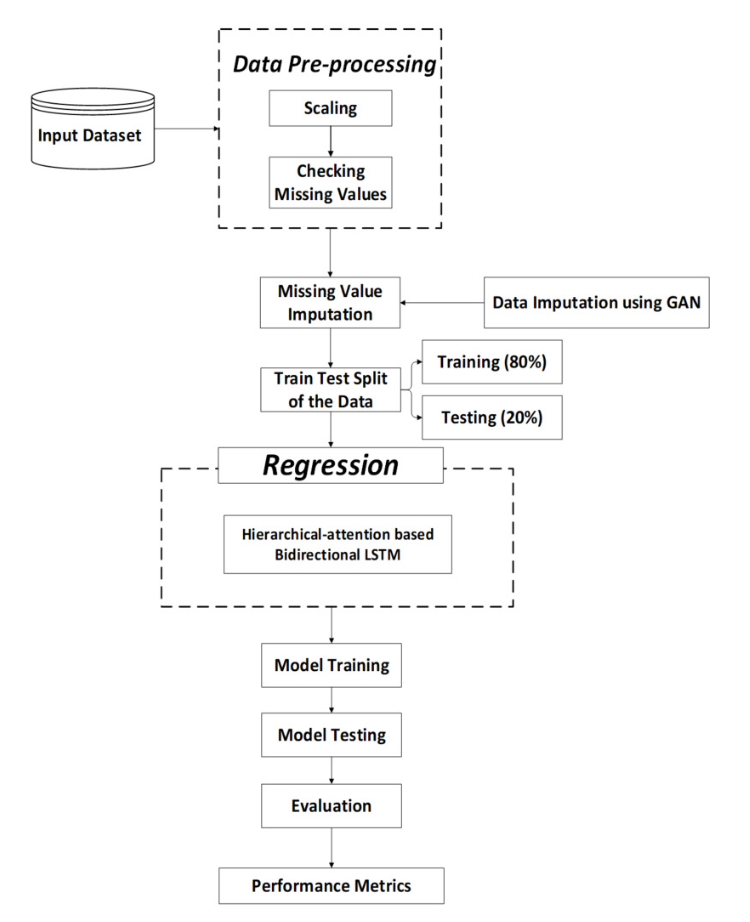Improving Air Quality Prediction with a Hybrid Bi-LSTM and GAN Model
Main Article Content
Abstract
Air quality is a topic that has been of utmost concern across the globe for the past few decades. Various intelligent monitoring systems are used in diverse scenarios, collecting air quality data that contains missing values. Such missing values in data cause hindrances in forecasting. This time series prediction or forecasting process extracts the necessary information from historical records and predicts future values. To solve the missing values issue in data, Generative Adversarial Networks (GAN) are used to impute the missed data. While the learning of long-term dependencies embedded in the time series poses another threat to the models in the time prediction. To overcome this, Long Short-Term Memory (LSTM) models are used. Yet, most of the neural network-based methods failed to consider the patterns of time series data that varied for each period, and the encoder-decoder performance deteriorated for longer sequences. To combat this, the present study proposes a hybrid probabilistic model to generate parameters for predictive distribution at every step. Hence, an implementation of hierarchical-attention-based BiLSTM with GAN is proposed in the study for effective prediction and minimal error. The proposed model is assessed with the evaluation metrics such as Mean Absolute Error (MAE) and Mean Absolute Percentage Error (MAPE), Root Mean Square Error (RMSE), and Mean Square Error (MSE). The evaluation metric confirmed the higher accuracy of the proposed model than the existing models in time series prediction.
Article Details

This work is licensed under a Creative Commons Attribution-NonCommercial-NoDerivatives 4.0 International License.
References
S. M. Hama, P. Kumar, R. M. Harrison, W. J. Bloss, M. Khare, S. Mishra, et al., “Four-year assessment of ambient particulate matter and trace gases in the Delhi-NCR region of India,” Sustainable Cities and Society, vol. 54, p. 102003, 2020.
M. Zamani Joharestani, C. Cao, X. Ni, B. Bashir, and S. Talebiesfandarani, “PM2. 5 predictions based on random forest, XGBoost, and deep learning using multisource remote sensing data,” Atmosphere, vol. 10, p. 373, 2019.
M. Dun, Z. Xu, Y. Chen, and L. Wu, “Shortterm air quality prediction based on fractional grey linear regression and support vector machine,” Mathematical problems in engineering, vol. 2020, 2020.
J. Wang, H. Li, H. Yang, and Y. Wang, “Intelligent multivariable air-quality forecasting system based on feature selection and modified evolving interval type-2 quantum fuzzy neural network,” Environmental Pollution, vol. 274, p. 116429, 2021.
S. Agarwal, S. Sharma, R. Suresh, M. H. Rahman, S. Vranckx, B. Maiheu, et al., “Air quality forecasting using artificial neural networks with real-time dynamic error correction in highly polluted regions,” Science of the Total Environment, vol. 735, p. 139454, 2020.
B. Liu, X. Tan, Y. Jin, W. Yu, and C. Li, “Application of RR-XGBoost combined model in data calibration of micro air quality detector,” Scientific Reports, vol. 11, p. 15662, 2021.
S. Siami-Namini, N. Tavakoli, and A. S. Namin, “A comparative analysis of forecasting financial time series using Arima, lstm, and bilstm,” 2019., arXiv:1911.09512. [Online]. Available: https://doi.org/10.48550/arXiv.1911.09512
S. Du, T. Li, Y. Yang, and S.-J. Horng, “Deep air quality forecasting using hybrid deep learning framework,” IEEE Transactions on Knowledge and Data Engineering, vol. 33, pp. 2412-2424, 2019.
Q. Tao, F. Liu, Y. Li, and D. Sidorov, “Air pollution forecasting using a deep learning model based on 1D convents and bidirectional GRU,” IEEE Access, vol. 7, pp. 76690-76698, 2019.
S. Pilleron, D. Sarfati, M. Janssen-Heijnen, J. Vignat, J. Ferlay, F. Bray, et al., “Global cancer incidence in older adults, 2012 and 2035: a population-based study,” International journal of cancer, vol. 144, pp. 49-58, 2019.
Y. Han, J. C. Lam, V. O. Li, and Q. Zhang, “A domain-specific Bayesian deep-learning approach for air pollution forecast,” IEEE Transactions on Big Data, vol. 8, pp. 1034-1046, 2020.
T. Kim, J. Kim, W. Yang, H. Lee, and J. Choo, “Missing Value Imputation of Time-Series AirQuality Data via Deep Neural Networks,” International Journal of Environmental Research and Public Health, vol. 18, p. 12213, 2021.
S. Yang, M. Dong, Y. Wang and C. Xu, “Adversarial Recurrent Time Series Imputation,” in IEEE Transactions on Neural Networks and Learning Systems, vol. 34, no. 4, pp. 1639-1650, 2023.
A. Bihlo, “A generative adversarial network approach to (ensemble) weather prediction,” Neural Networks, vol. 139, pp. 1-16, 2021.
Z. Zhao, J. Wu, F. Cai, S. Zhang, and Y.-G. Wang, “A hybrid deep learning framework for air quality prediction with spatial autocorrelation during the COVID-19 pandemic,” Scientific Reports, vol. 13, p. 1015, 2023.
K. H. Waseem, H. Mushtaq, F. Abid, A. M. AbuMahfouz, A. Shaikh, M. Turan, et al., “Forecasting of Air Quality Using an Optimized Recurrent Neural Network,” Processes, vol. 10, p. 2117, 2022.
K. Saikiran, G. Lithesh, B. Srinivas, and S. Ashok, “Prediction of Air Quality Index Using Supervised Machine Learning Algorithms,” in 2021 2nd International Conference on Advances in Computing, Communication, Embedded and Secure Systems (ACCESS), pp. 1-4, 2021.
M. Londhe, “Data mining and machine learning approach for air quality index prediction,” International Journal of Engineering and Applied Physics, vol. 1, pp. 136-153, 2021.


